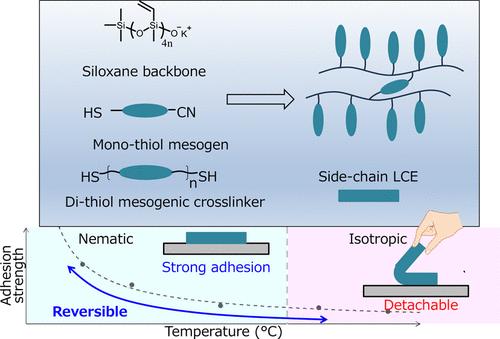Switchable Pressure-Sensitive Adhesion in Nematic Side-Chain Liquid Crystal Elastomers
IF 5.2
1区 化学
Q1 POLYMER SCIENCE
引用次数: 0
Abstract
Switchable pressure-sensitive adhesives (PSAs) offer promising opportunities for reusability, on-demand debonding, and programmable adhesion. In this work, we report the design and synthesis of a novel thiol-functionalized liquid crystal mesogen, enabling the fabrication of side-chain nematic liquid crystal elastomer (SC-LCE) adhesives via siloxane-based thiol-ene click chemistry. These materials uniquely combine the thermomechanical responsiveness of LCEs with rheological profiles that approach the Dahlquist criterion for ideal PSAs. Specifically, the resulting SC-LCEs exhibit a glass transition temperature of 6 °C and a rubbery plateau modulus of 0.3 MPa, achieved without the use of plasticizers, tackifiers, or other additives. In particular, our SC-LCE adhesives exhibit exceptional viscoelastic energy dissipation, with a peak loss factor (tanδ) of 2.81, and maintain high damping (tanδ > 1) over a wide temperature range (0–45 °C) in the nematic phase. SC-LCE adhesives also exhibit tackiness comparable to that of high-performance commercial adhesives such as VHB tapes while maintaining full thermal switchability. Furthermore, the peel and lap shear forces are more than double those of conventional main-chain LCEs. These findings represent a significant advance toward the development of high-performance, thermally debondable, and fully reusable PSA systems with promising implications for sustainable and reconfigurable adhesive technologies.

向列侧链液晶弹性体的可切换压敏粘附
可切换压敏粘合剂(psa)为可重复使用、按需脱粘和可编程粘合提供了很好的机会。在这项工作中,我们报告了一种新型硫醇功能化液晶介介物的设计和合成,使得通过基于硅氧烷的硫醇-烯点击化学制造侧链向列液晶弹性体(SC-LCE)粘合剂成为可能。这些材料独特地结合了lce的热机械响应性和流变特征,接近理想PSAs的Dahlquist标准。具体来说,SC-LCEs的玻璃化转变温度为6°C,橡胶平台模量为0.3 MPa,无需使用增塑剂、增粘剂或其他添加剂即可实现。特别是,我们的SC-LCE粘合剂表现出优异的粘弹性能量耗散,峰值损耗因子(tanδ)为2.81,并且在向列相的宽温度范围(0-45°C)内保持高阻尼(tanδ > 1)。SC-LCE胶粘剂还具有与高性能商用胶粘剂(如VHB胶带)相当的粘性,同时保持完全的热切换性。此外,剥离和搭接剪切力是传统主链lce的两倍以上。这些发现代表了高性能、热脱粘和完全可重复使用的PSA系统的发展取得了重大进展,对可持续和可重构的粘合剂技术具有重要意义。
本文章由计算机程序翻译,如有差异,请以英文原文为准。
求助全文
约1分钟内获得全文
求助全文
来源期刊

Macromolecules
工程技术-高分子科学
CiteScore
9.30
自引率
16.40%
发文量
942
审稿时长
2 months
期刊介绍:
Macromolecules publishes original, fundamental, and impactful research on all aspects of polymer science. Topics of interest include synthesis (e.g., controlled polymerizations, polymerization catalysis, post polymerization modification, new monomer structures and polymer architectures, and polymerization mechanisms/kinetics analysis); phase behavior, thermodynamics, dynamic, and ordering/disordering phenomena (e.g., self-assembly, gelation, crystallization, solution/melt/solid-state characteristics); structure and properties (e.g., mechanical and rheological properties, surface/interfacial characteristics, electronic and transport properties); new state of the art characterization (e.g., spectroscopy, scattering, microscopy, rheology), simulation (e.g., Monte Carlo, molecular dynamics, multi-scale/coarse-grained modeling), and theoretical methods. Renewable/sustainable polymers, polymer networks, responsive polymers, electro-, magneto- and opto-active macromolecules, inorganic polymers, charge-transporting polymers (ion-containing, semiconducting, and conducting), nanostructured polymers, and polymer composites are also of interest. Typical papers published in Macromolecules showcase important and innovative concepts, experimental methods/observations, and theoretical/computational approaches that demonstrate a fundamental advance in the understanding of polymers.
 求助内容:
求助内容: 应助结果提醒方式:
应助结果提醒方式:


